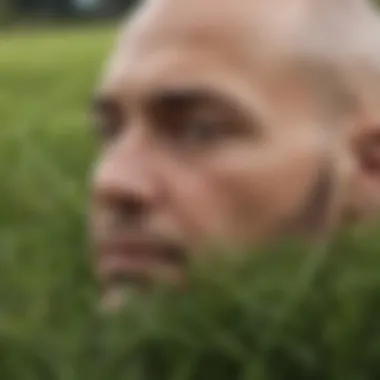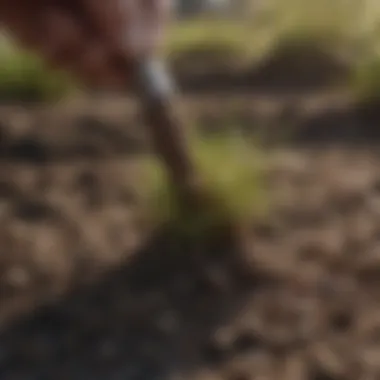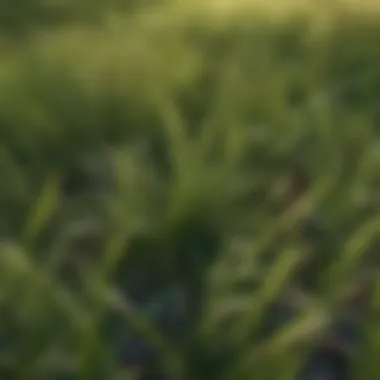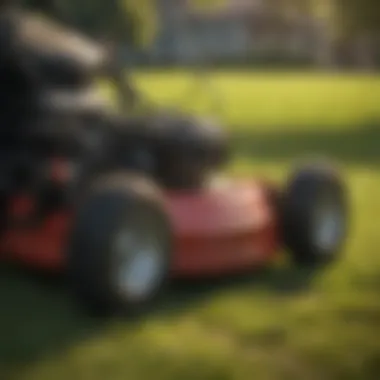Expert Tips for Repairing Grass Bald Spots


Intro
Grass bald spots can disrupt the aesthetic appeal of any lawn, damaging its uniformity and overall health. Understanding the underlying causes and diagnosing the specific needs of your grass are crucial steps in addressing these issues effectively. Whether due to pests, diseases, or environmental factors, it is possible to implement strategies that target these bald areas, fostering recovery and promoting robust growth.
The goal of this article is to offer a thorough guide that equips homeowners and gardening enthusiasts with practical knowledge and actionable insights. This includes both immediate tactics for rectifying visible bald spots and preventive measures that address long-term health. By recognizing the characteristics of your lawn and the factors that might be impacting it, you can choose suitable grass types, appropriate care practices, and successful maintenance strategies.
Understanding Grass Bald Spots
Grass bald spots can transform a vibrant lawn into an unsightly mess. A thorough comprehension of this issue is crucial for any lawn enthusiast. It assists in prevention and establishes the groundwork for effective remedies. A healthy lawn enhances the aesthetic appeal of a property while its poor condition can detract from it. Understanding the factors leading to bald spots enables proactive measures, reducing the risk of future occurrences. This knowledge also allows individuals to identify and react promptly to signs of stress in their grass, which contributes to overall lawn maintenance.
Definition and Characteristics
Grass bald spots refer to areas within a lawn where the grass has died or fails to grow. These spots can vary in size and may occur in patches or appear isolated. Identifying these bald areas is the first step in addressing them effectively. Characteristics to look for include color variations, texture differences, and the presence of weeds. Intentionally observing these features can help determine the underlying cause of the bald spots, whether it be related to environmental conditions, pest infestations, or maintenance practices.
Common Causes of Bald Spots
Bald spots can arise from numerous factors, each with distinct implications for lawn health. Understanding these causes is essential in developing appropriate solutions.
Environmental Factors
Environmental factors play a significant role in the health of lawns. Weather conditions such as excessive heat or extended periods of drought can lead to stress, resulting in dead patches on the grass. Soil drainage is another critical aspect; poorly draining areas may retain water, leading to root rot. The unique feature of these environmental influences is their variability. Each season can bring changes that impact grass growth differently. A major advantage of acknowledging these factors is the opportunity to tailor lawn care practices according to seasonal demands.
Pests and Diseases
Pests and diseases constitute another common reason for bald spots. Insects like grubs or beetles can damage grass roots, causing visible patches. Fungal diseases, including brown patch or dollar spot, present additional challenges. The key characteristic of these issues is their ability to spread quickly if left unchecked. Therefore, vigilance is essential. Early identification can significantly mitigate damage. The disadvantage here is that reliance on chemical treatments can lead to long-term soil health issues if not applied responsibly.
Improper Maintenance Practices
Improper maintenance practices are possibly the most preventable source of bald spots. Routine activities such as uneven mowing, over-fertilization, or inadequate watering can harm grass health. A key aspect is how these practices directly impact the grass's nutrition and growth. For instance, over-fertilization can lead to nutrient burn, creating barren areas. The unique attribute of these practices is that they are often within a homeowner's control, allowing for immediate correction. The benefit is significant; adapting maintenance routines can enhance grass vitality and aesthetics, ultimately leading to a healthier lawn.
"Maintaining a keen awareness of grass conditions can provide early insights into potential bald spot development."
Through understanding and addressing these aspects comprehensively, lawn caretakers can foster the conditions necessary for resilience and recovery, reducing the likelihood of bald spots while enhancing the overall vibrancy of their grassy surroundings.
Assessing the Damage
Assessing the damage in your lawn is a critical first step in addressing grass bald spots. You cannot fix what you do not understand. By carefully evaluating the condition of your grass, soil, and any potential pests or diseases, you can identify the precise issues that led to the problem. This step will help inform your subsequent actions and increase your chances of successfully restoring your lawn. Not only does effective damage assessment save time and resources, but it also optimizes lawn health in the long term.
Identifying the Type of Grass
Determining the type of grass in your lawn is essential for tailored care. Different grass types have varying sunlight, moisture, and fertilization needs. For instance, Kentucky bluegrass thrives in cooler conditions, while Bermuda grass prefers warmer climates. Knowing which type you are dealing with allows you to select the right methods and products for repair. Furthermore, some grasses are more resistant to specific pests or diseases, which can help guide your preventative measures.
Evaluating Soil Health
Soil health is a foundational aspect of lawn care. A healthy soil promotes robust grass growth and resilience against bald spots. Evaluating the soil involves two key components: soil pH testing and texture and structure analysis.
Soil pH Testing
Soil pH testing provides valuable insight into nutrient availability within your lawn. Healthy soil should have a pH between 6.0 and 7.5. If the pH is too high or too low, it can inhibit grass growth and promote bald spots. This testing is a widely used method because it is relatively simple and cost-effective. The unique feature of soil pH testing lies in its ability to indicate how well soil nutrients can be accessed by grass roots. However, the disadvantage is that it may not cover all soil factors affecting grass health.
Texture and Structure Analysis
Analyzing the texture and structure of the soil is another important aspect of assessing soil health. Soil texture affects drainage, nutrient retention, and root penetration. Different soil types—sandy, clay, or loamy—will provide varying degrees of support to grass growth. Texture and structure analysis is beneficial as it helps reveal whether compaction or poor drainage is contributing to bald spots. However, the drawback is the potential need for professional analysis if you want a comprehensive assessment, which may incur additional costs.


Diagnosing Issues
Diagnosing problems accurately is essential in the restoration of a lawn. Being able to identify specific signs can point you to the underlying causes of bald spots and prevent future occurrences. Focusing on two areas—signs of pests and identifying fungal diseases—helps clarify the issues at hand.
Signs of Pests
Recognizing signs of pests is crucial for quick intervention. Pests like grubs or chinch bugs can cause significant damage, leading to bald areas. Common indicators of pests include uneven growth patterns, yellowing grass, or visible insects on blades. This topic is popular among lawn care enthusiasts because early detection allows for effective pest management strategies to be implemented. However, one downside is that some lawn issues may be mistaken for pest damage, leading to misdiagnosis and ineffective treatment.
Identifying Fungal Diseases
Identifying fungal diseases is another aspect of diagnosing issues. Conditions such as brown patch or dollar spot can create unsightly bald spots in the lawn. The key characteristic of fungal diseases is their rapid spread under favorable conditions (like humidity). This subject is popular for those who want to maintain lawn aesthetics and health. Nevertheless, diagnosing fungal diseases can sometimes be tricky, as symptoms vary based on the disease and environmental conditions.
Immediate Solutions
In addressing grass bald spots, immediate solutions are vital. They provide quick intervention to mitigate further damage and initiate restoration. These solutions focus on patch repair techniques, proper watering practices, and the right fertilization. Each of these aspects allows for effective recovery, ensuring that the lawn regains its vigor and aesthetic appeal. Here, we will explore the key elements of these solutions and their benefits.
Patch Repair Techniques
Lawn Seed Spreading
Lawn seed spreading is a fundamental technique for fixing bald spots. It allows for new grass growth, which fills in areas where grass has died or thinned. The simplicity of this method is one of its greatest strengths. Homeowners can easily apply the seeds without needing professional help. Moreover, lawn seed spreading is cost-effective, making it an attractive option for many.
A key characteristic of lawn seed spreading is its ability to adapt to various grass types. This flexibility ensures that you can choose seeds that match your specific lawn conditions, enhancing the likelihood of successful germination. The process involves spreading grass seeds evenly over the affected area, followed by watering the seed to encourage growth. An essential advantage is that it encourages a fuller lawn over time. However, one downside to this method is that it requires patience and careful monitoring; growth may take several weeks.
Sod Replacement
Sod replacement is another popular and effective method for remedying bald spots. This approach involves placing pre-grown grass onto the bare area. The major advantage of sod is that it provides an instant visual improvement. It covers the bald spot immediately, blending seamlessly with the surrounding grass.
One distinct feature of sod replacement is its reduced time until establishment. Unlike seeds, which can take weeks to grow, sod can be walked on shortly after installation. This characteristic makes it preferred for many homeowners looking for immediate results. However, sod can be more expensive than simply spreading seeds, and it requires proper care during the initial days to ensure it roots well into the soil.
Watering Practices
Frequency and Amount
Watering is equally important in the process of lawn recovery. The frequency and amount of watering directly influence the success of both seed spreading and sod replacement. Proper hydration supports new grass growth and ensures that the existing grass remains healthy.
A vital aspect of this practice is to water deeply but infrequently, which encourages deep root growth. This method not only promotes recovery of the bald spots but also contributes to long-term health of the entire lawn. Frequent light watering can lead to shallow roots, making grass more susceptible to drought and disease. Thus, adjusting watering practices for newly patched areas is beneficial.
Timing for Optimal Growth
Timing is crucial when it comes to watering for grass recovery. Watering during early morning hours is often encouraged, as it provides the plants with moisture before the heat of the day. This helps to minimize evaporation and allows for better absorption by the grass roots.
The unique feature of this timing is its alignment with natural water cycles in many regions. Early morning watering complements other environmental factors, such as dew, and encourages optimal growth conditions. On the flip side, watering during hot afternoons can stress the grass, further hindering its recovery. Thus, finding the right watering time can significantly impact the success of lawn repair.
Fertilization for Recovery
Selecting the Right Fertilizer
Fertilization is an essential component of lawn recovery, especially following patch repair. Using the right fertilizer can significantly enhance the growth potential of both seeds and sod by supplying necessary nutrients. A balanced fertilizer with equal parts nitrogen, phosphorus, and potassium is often recommended for general recovery.
One notable characteristic is the ability of specific fertilizers to target recovery needs. For example, fertilizers formulated for establishing grass often contain higher phosphorus levels, promoting root development. While effective, improper use of fertilizers can lead to nutrient burn or encourage weed growth. Careful selection and application can optimize recovery and prevent these issues.
Application Methods


The method of fertilizer application can impact effectiveness as well. Various application methods exist, including granular spreading and liquid treatments. Each method offers distinct advantages based on specific lawn conditions and growth stages.
Granular fertilizers, for instance, provide a slow release of nutrients, which is beneficial for sustained growth. Conversely, liquid fertilizers offer fast absorption. Their unique feature is the immediate availability of nutrients to the grass. However, they often require more frequent applications. Therefore, choosing the preferred application method should depend on the lawn's current health and growth stage.
Long-Term Strategies
Addressing grass bald spots requires not only immediate solutions but also planning for the future. Long-term strategies ensure that the lawn remains healthy and minimizes the chances of bald spots emerging again. These strategies focus on improving soil quality, establishing a regular maintenance routine, and selecting grass varieties that can withstand stress. By taking a multidimensional approach, one can create a resilient lawn that thrives throughout the seasons.
Soil Improvement Techniques
Adding Organic Matter
Organic matter plays a critical role in enhancing soil health. It refers to decayed plants and animals that enrich the soil with nutrients. Adding organic matter contributes to better drainage and promotes earthworm activity. This, in turn, helps the grass roots to grow deeper, making the lawn more resilient to stress. The key characteristic of organic matter is its ability to retain moisture and nutrients, making it a popular choice for those looking to improve their lawn.
While adding organic matter has many benefits, it also requires careful management. Too much organic matter can lead to a soil structure that may retain excessive water, causing root rot. Moreover, sourcing high-quality organic material can take time and resources, thus requiring diligence and commitment from the lawn caretaker without being overwhelmed.
Using Soil Amendments
Soil amendments are materials added to soil to correct specific deficiencies. These might include lime for acidity, gypsum for clay soil, or compost to enhance nutrient content. The use of soil amendments contributes to achieving an ideal soil pH and improving its texture. A key characteristic is that these amendments can be tailored to specific soil needs, making them a versatile choice for lawn enthusiasts.
One unique feature of this approach is its focus on balancing soil properties, which directly supports healthy grass growth. On the downside, improper application can lead to overcorrection or inadequate results, highlighting the importance of conducting thorough soil testing before proceeding.
Regular Maintenance Schedule
Mowing Practices
Regular mowing is essential for maintaining an appealing lawn. It helps to control weeds, encourage denser grass growth, and prevents the grass from becoming too leggy. A key characteristic of effective mowing practices is the maintenance of proper height, which can vary according to the type of grass. For instance, fescue grass thrives when cut to about three to four inches, while Bermuda grass should be mowed shorter.
A unique feature of consistent mowing is its ability to promote lateral growth. This means that healthy grass can fill in gaps more quickly, reducing the likelihood of bald spots. However, mowing too short can distress the grass, making it susceptible to heat and drought, which can lead to further damage.
Seasonal Care Tips
Implementing seasonal care is another vital aspect of long-term lawn management. Each season presents unique challenges and opportunities for lawn care. For example, in the fall, aeration and overseeding can enhance the root system before winter. In the spring, focusing on fertilization and pest management stimulates growth. The key characteristic lies in aligning care activities with seasonal needs, providing targeted benefits throughout the year.
A unique feature of seasonal care is the ability to adapt to changing weather patterns. This approach helps reduce wasteful practices and ensures that inputs match plant needs. Yet, it often requires vigilant observation and flexibility, which can be difficult for busy homeowners.
Choosing Resilient Grass Varieties
Selecting resilient grass varieties is crucial for long-term lawn health. Native grass species or hybrid varieties known for drought resistance and pest tolerance can significantly reduce the occurrence of bald spots. These grass types often adapt better to local conditions and require less maintenance.
The importance of this choice cannot be overstated—it directly influences how well the lawn performs under stressors like heat and foot traffic. Resilient grasses often have deep root systems, which enhance soil stability. However, making the wrong choice can lead to compatibility issues with the environment, making prior research essential.
Summary: Implementing long-term strategies ensures lasting solutions for bald spots by focusing on soil health, maintenance processes, and grass variety selection. Commitment to these practices will yield a flourishing lawn well into the future.
Preventing Future Bald Spots
Preventing grass bald spots is essential for maintaining a healthy and visually appealing lawn. It is easier and often more cost-effective to prevent these issues before they arise than to deal with restoration efforts afterwards. The benefits of proactive practices include enhanced lawn health, reduced need for chemical treatments, and a more sustainable approach to lawn care. By understanding some key preventive measures, homeowners and lawn enthusiasts can create a vibrant green space that resists common threats.
Monitoring for Pests and Diseases
Regular monitoring for pests and diseases plays a crucial role in preventing bald spots. It involves frequent inspections of the lawn to identify early signs of trouble. Common indicators include discoloration of the grass, unusual patches, or visible insects. Homeowners should pay attention to changes, as issues can escalate quickly if not addressed.
A practical strategy for monitoring is to create a schedule for lawn checks, ideally once every week. During inspections, look for:


- Discoloration or wilting of grass.
- Insect activity or larvae in the soil.
- Fungal growth, such as mold or mushroom clusters.
Using tools like magnifying glasses and soil probes can facilitate thorough inspections. By identifying pests or diseases early, targeted measures can be taken before they cause severe damage.
Implementing Integrated Pest Management
Integrated Pest Management (IPM) is a comprehensive approach to manage pests in a sustainable way. It combines biological, cultural, physical, and chemical tools to minimize damages with less toxic means. By promoting an ecological balance, IPM not only prevents bald spots but also supports overall lawn health.
Key components of IPM include:
- Cultural control: Enhancing soil health with organic matter which stimulates grass root systems.
- Biological control: Encouraging natural predators of pests, like ladybugs.
- Physical control: Employing barriers or traps for effective pest management.
- Chemical control: Using pesticides only when necessary, ensuring they are precise and targeted.
Implementing IPM requires some planning and consistent observation, but it creates a resilient lawn over time while reducing dependence on chemicals.
Seasonal Lawn Care Practices
Seasonal lawn care practices are vital for sustainable lawn management. Adapting care methods to fit varying environmental needs throughout the year reduces the chance of bald spots.
Fall Preparation Tips
Preparing the lawn in the fall is critical for ensuring its health during winter. The grass should be mowed lower to encourage a stronger root system, and overseeding can be a good practice for thickening the lawn.
Key aspects of fall preparation include:
- Performing a final fertilizer application to feed the grass before dormancy.
- Aerating the soil to allow it to breathe and absorb water better.
- Applying mulch to retain moisture and regulate temperature.
These steps help the grass survive adverse winter conditions, and contribute to a lush growth in the spring. The choice to prepare in fall is a beneficial one, as it sets a solid foundation for the entire lawn.
Spring Recovery Strategies
Once spring arrives, it is equally important to implement recovery strategies to stimulate growth. Grass that may have gone dormant during winter often shows signs of recovery that need encouragement.
Spring practices should focus on:
- Early fertilization to provide essential nutrients for growth.
- Regular watering to keep soil moisture consistent as temperatures rise.
- Monitoring for signs of pests and diseases after the harsh winter.
Implementing these strategies promotes a healthy lawn through its active growth period. Adopting spring recovery tactics is not only beneficial; it is essential for matching the lawn's growing cycle. With proper care, the lawn can emerge vibrant and green, reducing the likelihood of bald spots appearing as the warmer months approach.
By incorporating monitoring, pest management, and seasonal care into lawn care routines, homeowners can significantly reduce the risk of future bald spots. It is a meaningful investment in the longevity and health of their lawns.
Ending
Addressing grass bald spots effectively is crucial to maintaining a healthy and attractive lawn. This article has explored various aspects of repairing these unsightly areas, emphasizing the importance of understanding the causes, using diagnostic techniques, and implementing both immediate and long-term solutions. By learning how to remediate these bald spots, homeowners and lawn care enthusiasts can enjoy the aesthetic appeal of a lush lawn. It also contributes positively to the overall health of the grass.
Summarizing Key Points
In summary, the key points covered in this article include:
- Identifying Causes: Recognizing why bald spots occur is essential. This includes environmental factors, pest infestations, and improper maintenance practices.
- Assessing Damage: Understanding the specific type of grass and evaluating soil health can inform the corrective actions needed.
- Immediate Solutions: Employing patch repair techniques such as seed spreading or sod replacement, coupled with proper watering and fertilization practices, helps regain lost lawn coverage quickly.
- Long-Term Strategies: Soil improvement and regular maintenance schedules ensure that bald spots do not become a recurring problem. This involves choosing resilient grass varieties that fit the local environment.
- Preventive Measures: Monitoring for pests and diseases, and implementing seasonal care practices, prepares the lawn for any potential threats.
By synthesizing these methods, you can restore your lawn to its original health and beauty. A well-maintained lawn is an asset that enhances the value of any property.
Encouragement for Ongoing Lawn Care
A successful lawn care regimen is not a one-time action but rather a continuous effort. It is important to incorporate the lessons learned from this article into your routine. Regularly examining your lawn for issues, maintaining proper watering practices, and applying fertilizers appropriately are great ways to foster long-lasting health in your grass. Consistency is key in effective lawn care, providing monitoring and timely responses to problems.
Investing time in your lawn yields high returns in beauty and enjoyment. Take pride in your efforts, and remember that the care you invest now will result in a vibrant and healthy lawn in the seasons to come.
Stay proactive in your approach to lawn health, so bald spots become a rare occurrence.















